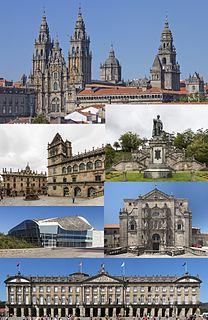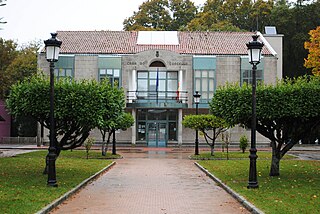
Galicia is an autonomous community of Spain and historic nationality under Spanish law. Located in the northwest Iberian Peninsula, it includes the provinces of A Coruña, Lugo, Ourense and Pontevedra.

Santiago de Compostela is the capital of the autonomous community of Galicia, in northwestern Spain. The city has its origin in the shrine of Saint James the Great, now the Cathedral of Santiago de Compostela, as the destination of the Way of St. James, a leading Catholic pilgrimage route since the 9th century. In 1985, the city's Old Town was designated a UNESCO World Heritage Site.

A torc, also spelled torq or torque, is a large rigid or stiff neck ring in metal, made either as a single piece or from strands twisted together. The great majority are open at the front, although some had hook and ring closures and a few had mortice and tenon locking catches to close them. Many seem designed for near-permanent wear and would have been difficult to remove. Torcs are found in the Scythian, Illyrian, Thracian, Celtic, and other cultures of the European Iron Age from around the 8th century BC to the 3rd century AD. For the Iron Age Celts, the gold torc seems to have been a key object. It identifies the wearer as a person of high rank, and many of the finest works of ancient Celtic art are torcs. The Celtic torc disappears in the Migration Period, but during the Viking Age torc-style metal necklaces, now mainly in silver, came back into fashion. Torc styles of neck-ring are found as part of the jewellery styles of various other cultures and periods.
The Xunta de Galicia is the collective decision-making body of the government of the autonomous community of Galicia, composed of the President, the Vice-President(s) and the specialized ministers (Conselleiros).

The University of Vigo is a public university located in the city of Vigo in the Province of Pontevedra, Galicia, Spain. There are three campuses:

The Iberian Peninsula has been inhabited for at least 500,000 years, first by Neanderthals and then by modern humans.

Castro culture is the archaeological term for the material culture of the northwestern regions of the Iberian Peninsula from the end of the Bronze Age until it was subsumed by Roman culture. It is the culture associated with the Gallaecians and Astures.

Cambre is a municipality in the Province of A Coruña, in the autonomous community of Galicia in northwestern Spain. It is located 12 km from the capital city of A Coruña and ten minutes away from the city's airport, Alvedro.

The Minho or Miño is the longest river in Galicia, sharing the border with Portugal, with a length of 340 kilometres (210 mi). By discharge, it is the fourth river of the Iberian peninsula, after the Douro, Ebro, and Tagus.

Galicians are a Celtic-Romance ethnic group from Spain that is closely related to the Portuguese people and has its historic homeland is Galicia, in the north-west of the Iberian Peninsula. Two Romance languages are widely spoken and official in Galicia: the native Galician and Spanish.

Santiago–Rosalía de Castro Airport, previously named Lavacolla Airport and also known as Santiago de Compostela Airport, is an international airport serving the autonomous community and historical region of Galicia in Spain. It is the 2nd busiest airport in northern Spain after Bilbao Airport. It has been named after the Galician romanticist writer and poetess, Rosalía de Castro, since 12 March 2020.

Xaquín Lorenzo Fernández, Xocas, was a Spanish educator. He studied in Ourense, and his teacher was Ramón Otero Pedrayo. He studied philosophy and letters in Santiago de Compostela and Zaragoza.

O Saviñao is a Concello (council) in the province of Lugo, Galicia belonging to the district of Terra de Lemos. The main town for the council is Escairón.

The Broighter Gold or more correctly, the Broighter Hoard, is a hoard of gold artefacts from the Iron Age of the 1st century BC that were found in 1896 by Tom Nicholl and James Morrow on farmland near Limavady, in the north of Ireland. The hoard includes a 7-inch-long (18 cm) gold boat, a gold torc and bowl and some other jewellery.

Ourense Cathedral is a Roman Catholic church located in Ourense in northwestern Spain. Dedicated to St Martin, it was founded in 550. The first structure was restored by Alonso el Casto. The present mainly Gothic building was raised with the support of Bishop Lorenzo in 1220. Its local patroness is Saint Euphemia. There is a silver-plated shrine, and others of St Facundus and St Primitivus. The Christ's Chapel was added in 1567 by Bishop San Francisco Triccio. It contains an image of Christ, which was brought in 1330 from a small church on Cape Finisterre. John the Baptist's Chapel was created in 1468 by the Conde de Benavente. The Portal of Paradise is sculptured and enriched with figures of angels and saints, while the antique cloisters were erected in 1204 by Bishop Ederonio. The Capilla de la Maria Madre was restored in 1722, and connected by the cloisters with the cathedral. The eight canons were called Cardenales, as at the Cathedral of Santiago de Compostela, and they alone did services before the altar; this custom was recognised as "immemorial" by Pope Innocent III, in 1209. The cathedral, which has undergone an impressive transition of architectural styles of Romanesque, Gothic, Renaissance, Baroque and Neoclassical, was built to a Latin Cross plan. It has been a functional basilica since 1887. The cathedral has a crucifix that is held in great reverence all over Galicia.

The Madrid–Galicia high-speed rail line is a high-speed railway line in Spain that links the city of Madrid with the region of Galicia via the cities of Olmedo, Zamora, Ourense and Santiago de Compostela. The line also connects the Atlantic Axis high-speed rail line to the rest of the Spanish AVE high-speed network. The Madrid–Galicia high-speed rail line is constructed as double electrified line and is designed for trains running at speeds up to 350 kilometres per hour (220 mph).
The Atlantic Axis high-speed rail line, also called Atlantic Corridor high-speed rail line, is a high-speed railway line that links A Coruña, Santiago de Compostela, Pontevedra and Vigo in Spain. The Atlantic Axis was inaugurated in April 2015.

The Sintra Collar is a Bronze Age gold neck-ring found near Sintra in Portugal. Since 1900, it has been part of the British Museum's collection and has long been admired for the sophistication and geometric beauty of its design and technique.

The Cordoba Treasure, or Tesoro de Córdoba in Spanish, is the name of a major Iron Age silver hoard found on the outskirts of the city of Córdoba, Spain in 1915. The entire treasure was purchased by the British Museum in 1932, where it has been on public display ever since.

The Pontevedra Museum is a museum in the Galician city of Pontevedra in Spain. It was founded by the Provincial Deputation of Pontevedra on 30 December 1927 and has six buildings for its exhibitions. It has permanent and temporary exhibition rooms. The museum's collections are multidisciplinary, classified into rooms for painting, sculpture, archaeology, decorative arts, engraving and ethnography.























